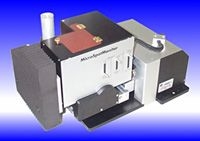 Add My Company
Add My Company
Sign In

Measuring position and dimension of the focusThe MicroSpotMonitor is the favorite tool to investigate, qualify or simply to check (for quality control reasons) very small laser beams for instance used in laser micro machining.ApplicationThe MicroSpotMonitor measures the power density distribution automatically at different z-positions of the beam within a few minutes.The following results are obtained:
Power density distribution at the measurement planes
The dimensions of the laser focus: diameter, divergence, rayleigh length
The focus position in space
Beam propagation ratio M²
The measurements are based on ISO 11145/11146Technical descriptionThe Laser Beam is scanned with a rotation pinhole (about 20 µm in diameter). This pinhole is used to couple out a small part of radiation in the focus region. With two mirrors the signal target is directed to the detector. Then the electrical signals are digitized with work pieces power densities of several MW/cm². The divergence of the radiation in most cases is low. This leads to f- numbers (ratio of focal length of the optics to diameter of the unfocussed beam) of normally b12 bit resolution and transferred to a computer. The positions of the scanning traces (x) are movable in y- and z- direction. So it is possible to measure a complete beam caustic within some minutes.In the standard configuration the FocusMonitor is designed to measure IR- lasers (CO2 or Nd:YAG- laser) with a output power of several hundret watts up to many kW. These lasers reach in standard applications like cutting or welding of typical metallic igger than 4.The central unit of the FocusMonitor is the scanning mechanic with the control of the three axis of motion.With different detectors and special measuring tips it is easy to expand the field of applications of the FocusMonitor. So it is possible to detect also highly divergent beam as generated by high power diode lasers. Also beams with more than 10 kW CO2- laser radiation can be analyzed. But even higher laser sources with a power of only a few watt can be measured.Due to the high speed of the measuring tip (up to 10- 40 m/s) no material ablation takes place on the surface. In addition the measuring tip is made of material which is corrosion and temperature resistant.The dynamic of the used 12 bit analog to digital converter ensure a high signal to noise ratio. This is - beside other features - the basis for an automatic caustic measurement accroding to the ISO 11146 standard. The request of the ISO is to measure within the direction of beam propagation four times the Rayleigh length minimum. Within the measuring range the power density varies a factor of four and the signal to noise ratio should not be higher than 100:1.The relative spatial resolution of the FocusMonitor can be adjusted between 32x32 up to 256x256 pixel in the scanning array. So it is possible to detect even small disturbances in the power density. With the standard settings of 64x64 pixel measurements with high speed and sufficient accurracy can be realized.Technical data
Beam diameter 10 µm up to 2 mm
Spectral region 248 nm up to 1100 nm
Max. average power 200 W (from ca. 1 mW)
Max. energy density Damage threshold of the measuring optics up to 3 J/cm² at 10ns pulse length
Max. power density 10 GW/cm² im cw-Betrieb
Dimensions (H x L x W)
(plus connectors) 202 mm x 219 mm (+30 mm to measuring position) x 429 mm
Control and presentationThe measurement of the focus is done using a diffraction limited optics projecting the image of the power density distribution onto a CCD-sensor. The magnification of the various objectives is 1:1 to 1:30. This enables the user to measure even highest power densities.
Between objective and detector, a sophisti-cated attenuation system is integrated.
The CCD-sensor itself has a dynamic of about 55 dB at a fixed integration time.
With the additional control of integration time (12 µs to 200 ms) the dynamic range can be expanded to about 80 dB. This leads to a range of more than 130 dB.
In every case, the dynamic is sufficient for a caustic measurement, which requires a range of more than 4 Rayleigh lengths, according to ISO 11146. With the integrated z-axis the MicroSpotMonitor can run such measurements within around a minute.
For more information, please visit our website - www.lasertrader.co.uk or alternatively you can call us on – 01246 229159
For more information on Micro-spot-monitor talk to Laser Trader Limited
Enquire Now
List your company on FindTheNeedle.

